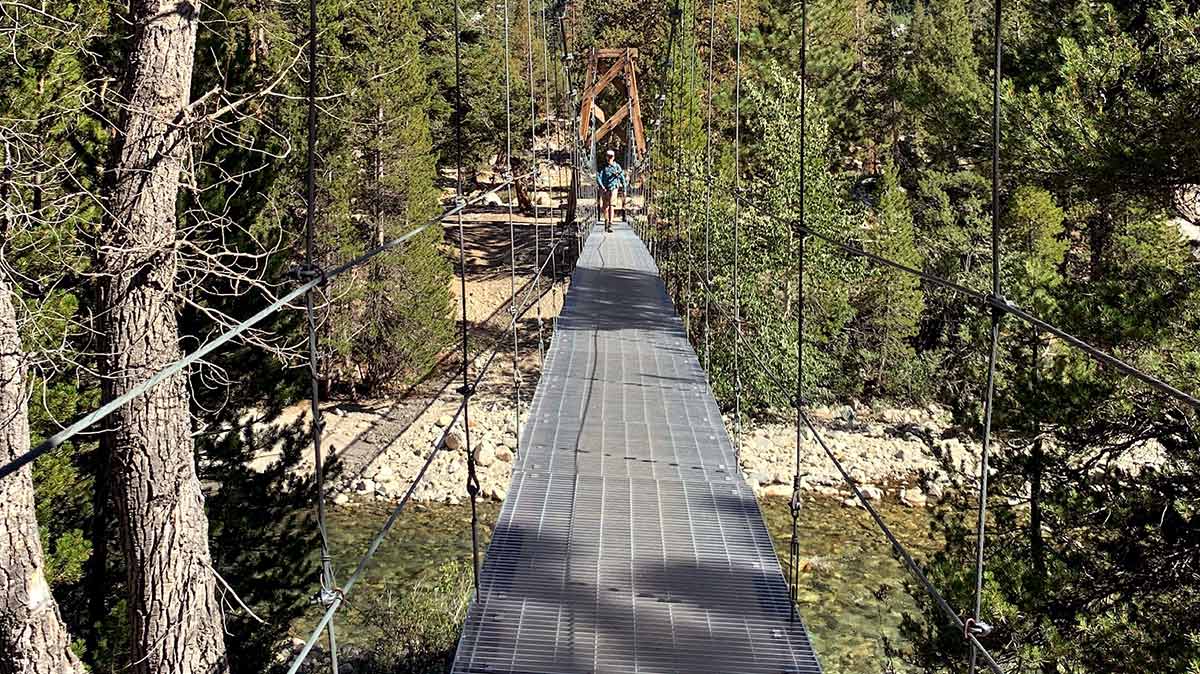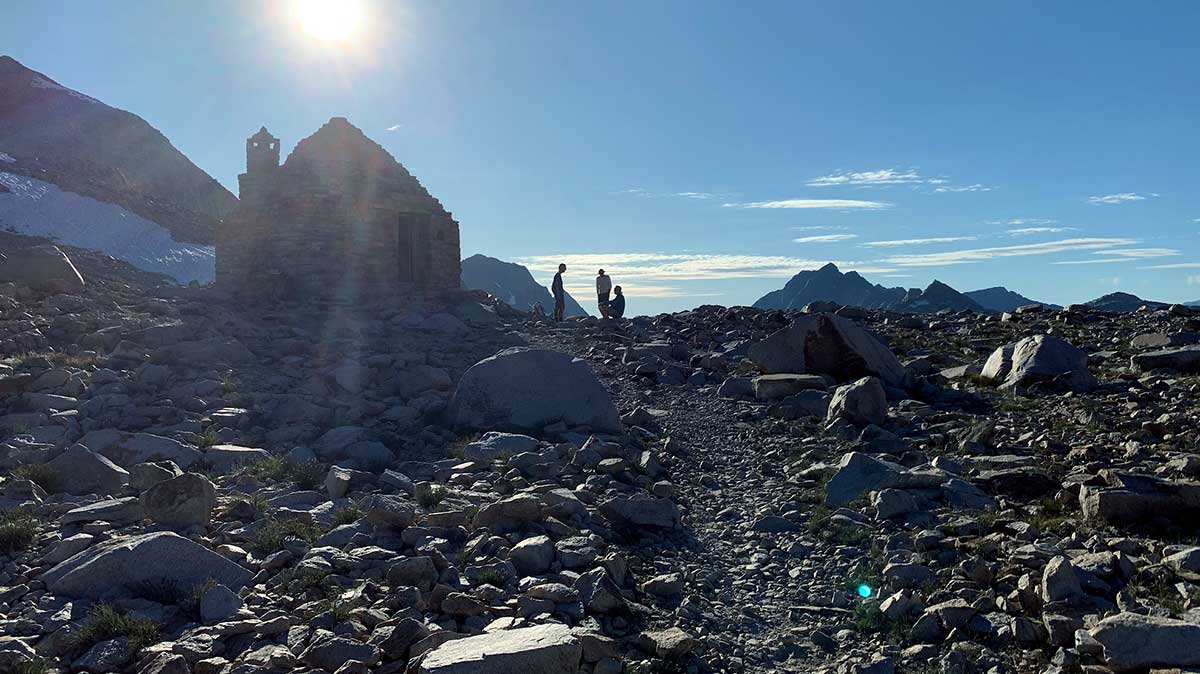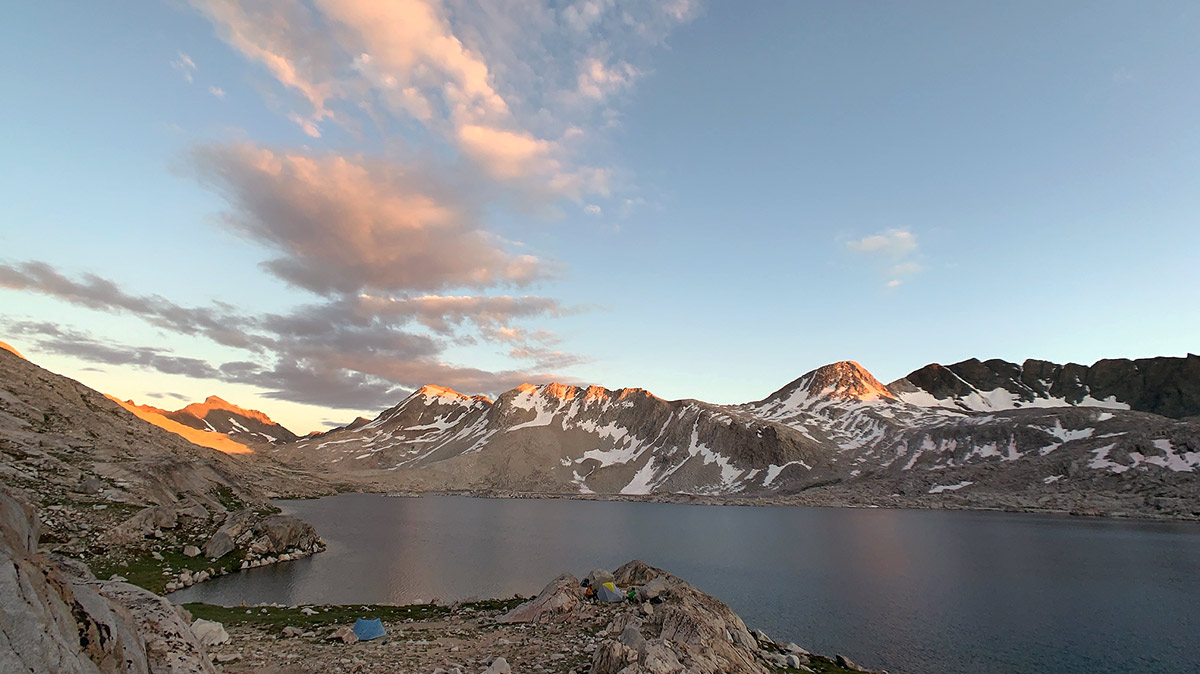The Sierra are incredibly important to me. These mountains have given me so much, including finding a place where I was comfortable and found belonging as a kid (growing up in a place where I never quite fit in), to finding my strength as a young man surviving extended solo missions and nearly losing my life on Muir Pass 20 years before. The Sierra made an indelible impression on my life and I have centered myself around being outside and moving myself across mountains ever since those formidable years.
My buddy Craig and I had attempted the John Muir Trail 2 years earlier and decided to come back for another go. We both have spent a lot of time in the mountains solo (he’s completed both thru-hiking and bikepacking triple-crowns), and both carry everything we need to be self reliant—while maintaining a fast and light ethos. This meant we had a couple nights we were chilly, and meant when I suffered a severe ankle blow out we had to have some serious discussions about food since we were both carrying so little.
We decided to hike north-bound from Whitney to Yosemite Valley—which kept us above 10,000′ for the first several days, and gave us shorter but steeper passes to navigate. We started south of the true JMT at Cottonwood Lakes (on my 45th birthday!) which added an extra 20’ish miles to our thruhike. We had a target of around 20 miles per day, which we hovered right around for the majority of our trip.
Like all good adventures, this one started with thumbs out on the side of the road trying to get a few hundred miles south to the start of the dirt…
This first few days of our hike I had a mild degree of anxiety, constantly doing self checks and hoping I wouldn’t have the same asthma-induced altitude issues I had 2 years ago. [In 2017 we self evacuated to the hospital in Lone Pine—try to never go there… 1 star—when I was having uncontrollable body shakes and a couple asthma attacks].
The morning of our Whitney summit, and the true start of the NOBO JMT, we woke up before dawn to start the hike from Crabtree Meadows–I was feeling fantastic. My body and mind felt strong and I was feeling hugely relieved. We had a steady hike up to the summit at 14,505’ (which is now several feet higher than it’s official 14,494’ elevation when I last summited it in 1989). It took us 10 hours to do the 15 mile round trip up to the peak and back down. Craig and I decided to take a late afternoon nap and then we packed up our camp and hiked another 4.4 miles to Wallace creek for the evening.
The 4th day was the crux of this trip for me… walking down off of Bighorn Plateau towards Tyndal Creek, I slid off a large rock in the trail and rolled my ankle—spectacularly. Craig turned and looked at me with a surprised/horrified look from the loud popping sound my ankle made. I have loose ankles. I roll them not-infrequently. The last time I rolled an ankle this bad was a week before another planned JMT attempt many years ago that resulted in me barely being able to walk for a few weeks. This was bad.
I hobbled the next few miles down to the creek where I soaked it in the freezing water. The swelling was quick and making my shoe uncomfortable. The pain was severe and I had the feeling of tightness around my ankle and down around the bottom of my foot. I knew I tore the same tendons I had torn a few years ago [I ran into a pair of nurses on the trail the next day that confirmed this for me–and also gave me the welcomed encouragement that while it would hurt like hell, I wouldn’t do any more damage than I already had if I just kept going].
I was determined to finish this trail this year. With tears in my eyes (partly out of total frustration of this trail denying me for so many years, and partly with pain), I told Craig I was going to keep walking.
The next day we had a long discussion about him continuing on without me. We didn’t have very much food because of our plan to move fast and light, and I was moving pretty slow. If I couldn’t keep up the miles we would definitely run out of food a day or so before we got to our resupply, and we needed every calorie we could get. Craig insisted on staying with me, and luckily through the pain I was able to keep the miles up in the mid to upper teens for the first couple days until we ramped it back up. The ankle never stopped hurting on this trip and every down hill for the next week and a half was excruciatingly painful. It wouldn’t be until the following summer back home in the Wasatch Mountains that I would be able to hike and run on dirt again, almost normally.
Forester Pass may be one of my favorite passes I’ve crossed. Despite walking over this pass half a dozen or so times over the past 30 years, the north side always takes my breath away. It is cut into sheer cliff sides and I always think between heavy breaths about the men who built this and how burley they must have been. The views off of both sides are magnificent and it is remote enough that you get a true feeling of wilderness looking up and down the crest of the Sierra.
Muir Pass—Emotional highs and lows.
The summer of 1998 I attempted to solo the Sierra High Route. It was a high snow year and the rivers in the valley bottoms were all swollen beyond comprehension, and there was extensive lingering snow fields even in the end of summer when I made my attempt. Due to snow, and being alone, I made the decision to bail on the High Route and instead hop onto the John Muir Trail and just cruise north for the weeks I had off of work.
The day after I made that decision and dropped down off of the Sierra crest, crossing a normally small creek (that even at it’s small size normally had a bridge over it) I nearly drowned. And by nearly I mean I was pinned so firmly against a large boulder I couldn’t see, with my full pack on, that I couldn’t move. I can still very clearly remember what seemed like minutes under that water feeling the pain from the extreme cold of the water leave my arms and legs as I lost feeling and the dizziness from lack of oxygen. By some miracle a random hiker (I hadn’t seen anyone in days) saw me disappear under the water and was able to jump to the edge and fully lift my 160lbs + 50lb pack right out of the water.
2 days later I was walking over Muir Pass trying to get out of the mountains and I punched through a snow bridge over the waterfall on the east side of the pass. I knew that waterfall was there—I had been here before—but with the full pass covered in snow I just forgot.
Once again my mortality was front and center as I laid down and slowly rolled several feet up the snow bank trying desperately to get off the inches-thick overhang I found myself on. The slowness of my movement and how long it took me to roll/drag myself to relative safety, directly contrasted with how loud and fast everything seemed around me, and how pressing it was I moved before it gave way and my body disappeared into the loud darkness below me for who knows how many years.
That was the last time I was on Muir Pass. This was also when I stopped doing solo backcountry trips. Facing a pair of near death experiences, deep in the backcountry by yourself is incredibly lonely. This year, I was glad for the company and sun and grass and rocks, walking up the pass with Fowler and the other people we would intermittently pass heading both directions.
The entire day Craig and I spent climbing up the valley and crossing creeks and then summiting this pass was pretty emotional. I didn’t tell many people about those events 20 years ago until about 10 years after they happened. It was hard to talk about (and I couldn’t tell my mom the whole story for almost 15 years). Seeing the pass, walking past that waterfall, and seeing the west side of the pass were glorious. Despite the pain in my ankle I couldn’t be happier, and we had a spectacular sunset and campsite above Wanda Lake to the west.
One of the highlights of all my years in the mountains came on this trip, walking around the alpine lakes near Lake Virginia. There was an older couple in their 70’s camped off the trail who I talked to as I was walking by. They were the happiest most lovely people I may have ever talked to. As I walked by she exclaimed, “I’ll sing you up the trail!“, and in the most incredibly beautiful voice she sang in a tremolo what sounded like a song from the old-country about the beauty of the mountains that ended with her singing, “…with beauty like that how can you not sinnnnng?“. I turned around to applaud her and she was twirling across the meadow with barefeet and her arms in the air as her husband was smiling from ear to ear and softly clapping.
It was one of the most beautiful things I’ve ever seen and I immediately started crying. The mountains and the lake in the background, and her as happy as a little girl singing in an alpine meadow. It still makes me tear up thinking about it. As I climbed out of that lake basin with tears in my eyes there were heart-shaped rocks everywhere, and the sun came out after a day of clouds. It was like I just heard an angel sing and the whole world was singing with her. I love these mountains.
A resupply at Red’s Meadow on our 11th day also means burgers at the cafe. It is amazing to think they let people that smelled as bad as we did inside.
Garnet Lake framing Banner and Ritter Peaks in the background is one of my favorite places in the Sierra. This day there were intimidating thunder and storms strafing those peaks and the whole day we were nervous about lightening and impending rain… but we managed to just skirt any serious storms (we would later hear pinned several people down in their tents for most of the day). Our timing was just right and we were in sync with the rhythm of the mountains we were moving through.
As we got closer to Yosemite Valley and our elevation dropped, the early-September mornings got damper and colder. Our morning routine of waking and breaking down camp got even faster and we would walk the chill off while eating our 1st breakfast. This morning when the sun cracked over the valley walls we just stood, steaming, and soaking in all the sun and warmth we could.
Tuolomne Meadows has a small store that serves breakfast and lunch that is crowded with thruhikers—even this late in the season. I had been dreaming about hot coffee and sausage and eggs for several days. It didn’t disappoint. And the conversation with other thruhikers on trail conditions, and crowds, and weather was welcome.
Our final night we pitched our camp just shy of 10 miles above Happy Isles and the end of our backcountry adventure. We shared one of few freeze-dried meals I had brought, and I had a celebratory beer that someone had given me in Tuolomne meadow earlier in the day that I had stashed for the final meal.
It was a bittersweet evening knowing this was our last night in the mountains, and the next morning we would be passing throngs of tourists slathered head to toe in incredibly strong soaps and perfumes and bug sprays. I know we smelled like a homeless camp after almost 2 weeks in the backcountry, but coming back to civilization is always an assault on all of the senses.
This was one of the hardest trips I have completed because of how badly I had rolled my ankle in the first few days. It would take almost a year until I could trust it on uneven trails again. But once again, Fowler and I had an incredible adventure we had completed together. Two weeks was just enough time to really start to settle into the rhythm of living outside, and it was bittersweet to finish.
We spent the day in Yosemite Valley, sending postcards, calling our families, and eating pizza (the minute the pizza stand opened). We hopped a couple busses to get to half dome and laid in the meadow watching climbing parties high up on the face, before catching a YARTS bus to Mammoth to pick up Fowlers Sprinter Van at the lot outside of town we stashed it in 2 weeks before. The next morning we found showers and changed into our clean clothes. I grabbed a flight back to Utah to see my lady, but he stayed in the Sierras a few more days to bikepack the Lake Trail. It’s good to have friends to do the big trips with—especially friends that are always pulling you out to take on the bigger challenges that most of your people think are too ambitious.
































































